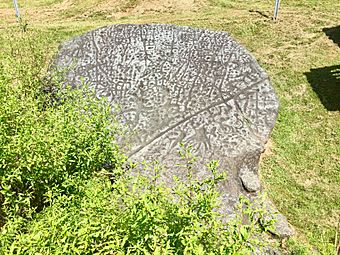Judaculla Rock facts for kids
Quick facts for kids |
|
|
Judaculla Rock
|
|

Judaculla Rock, August 2018
|
|
| Location | 552 Judaculla Rock Rd., Cullowhee, North Carolina |
|---|---|
| NRHP reference No. | 13000116 |
| Added to NRHP | March 27, 2013 |
Judaculla Rock is an amazing ancient site in the mountains of Western North Carolina. It features a large, curved rock made of soapstone that is famous for its old carvings, called petroglyphs. These are designs pecked or cut into the rock. The site is about 60 meters (200 feet) east of Caney Fork Creek, which flows into the Tuckasegee River.
The rock with the carvings sits in a special bowl-shaped area that was made by people long ago. Today, this area is covered with grass. Nearby, there are smaller soapstone rocks that show signs of ancient people cutting out pieces to make bowls. Judaculla Rock is so important that it is listed on the National Register of Historic Places.
Contents
What is Judaculla Rock?
The main rock at Judaculla is covered with petroglyphs. It's about 22 square meters (237 square feet) in size and slopes towards the west. You can also see marks on the rock where people used to cut out pieces of soapstone to make bowls. Some spots show where they removed stems, possibly for pipes, and there are also hollow, curved shapes.
The Amazing Carvings
The surface of Judaculla Rock is packed with many different petroglyphs. It can be hard to tell them apart because there are so many, especially on the top part of the rock. But experts have counted at least 1,458 small round "cup marks." There are also 47 curvy shapes, 10 bowl-shaped dips, 10 stick-like figures, 9 grooves, 3 designs with rings inside each other, 3 more curvy patterns, 3 deer tracks, 2 claw-like prints, 1 arc, 1 cross inside a circle, and 1 winged shape.
When Were the Carvings Made?
Some of the petroglyphs are found inside the hollow shapes left from when people stopped taking soapstone for bowls. This suggests that the carvings were made after the soapstone quarrying (mining) had finished. Similar findings have been made at other rock sites in North Carolina and Georgia.
Dating the Designs
By comparing the designs on Judaculla Rock, like the concentric rings and the cross-in-ring, to patterns found on old pottery from the area, experts can guess when they were made. It seems the petroglyphs were created sometime between the Middle Woodland and late Mississippian culture periods. This means they could be from around 200 CE to 1400 CE.
Clues from the Ground
Archaeologists have dug around the rock to find clues about its age. They found that the soil near the rock has been disturbed, probably by farming a long time ago. This makes it hard to date things perfectly. However, samples taken higher up the slope show undisturbed layers of soil. These layers contain pieces of soapstone and other stone, which suggest that soapstone bowl making happened there during the Late Archaic period, roughly 2000 to 1000 BCE.
Judaculla Rock and Cherokee Stories
Judaculla Rock is very special to the Cherokee people. Even though many Cherokee were forced to move in 1839, both the tribes in Oklahoma and the one in North Carolina still share their old stories. Cherokee tales connect Judaculla, who is also known as Tuli-cula or Tsulʻkalu, their "Master-of-Game" (a spirit who looks after animals), with the land around the rock, including mountains, rivers, and old Cherokee towns.
The petroglyph rock is on an old path that connected the former Cherokee townhouse (a main building in a Cherokee town) at Cullowhee with Judaculla's own special townhouse, which was believed to be in Tannasee Bald. Today, the Eastern Band of Cherokee Indians lives in Western North Carolina and, along with other Cherokee tribes, still sees this rock as very important spiritually.
Why is Judaculla Rock Important?
From the point of view of rock art, Judaculla Rock is incredibly important. It has more petroglyphs than any other known rock east of the Mississippi River! Judaculla Rock has about 1,548 carvings, which is almost four times more than the 421 carvings at the large Track Rock Gap site in Georgia.
Archaeological Discoveries
From an archaeological perspective, the undisturbed soil layers higher up the slope from Judaculla Rock contain physical evidence of ancient soapstone quarrying and bowl making from the Late Archaic period. The location of Judaculla Rock, between the Cullowhee townhouse and Judaculla's townhouse in Tannasee Bald, is also mentioned in Cherokee stories about other petroglyph rocks. These locations show how the Cherokee connected their summer farming in the valleys to their fall and winter hunting in the mountains. It's also thought that these petroglyph rocks might be like old maps of the land where they are found.
Judaculla Rock seems to be a physical representation of the entire landscape where the Cherokee lived. It's a unique example of petroglyph rocks in the area, and more study will likely teach us even more about the history of this region.
Protecting the Rock
Many groups worked together in Jackson County to protect Judaculla Rock. These included the Parker family (who used to own the land), the North Carolina Rock Art Project, the Eastern Band of Cherokee Indians, Western Carolina University, the North Carolina Department of Cultural Resources, and the Caney Fork Community Council. Together, they built a special viewing platform at the site, along with signs to explain its history. This effort to protect and manage Judaculla Rock is a great example of how other rock art sites can be saved and shared with visitors for many years to come.
In 2013, Judaculla Rock and its site were officially added to the National Register of Historic Places.



